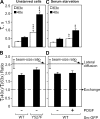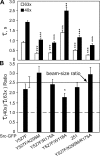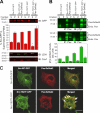Src kinase activity and SH2 domain regulate the dynamics of Src association with lipid and protein targets
- PMID: 17698610
- PMCID: PMC2064473
- DOI: 10.1083/jcb.200701133
Src kinase activity and SH2 domain regulate the dynamics of Src association with lipid and protein targets
Abstract
Src functions depend on its association with the plasma membrane and with specific membrane-associated assemblies. Many aspects of these interactions are unclear. We investigated the functions of kinase, SH2, and SH3 domains in Src membrane interactions. We used FRAP beam-size analysis in live cells expressing a series of c-Src-GFP proteins with targeted mutations in specific domains together with biochemical experiments to determine whether the mutants can generate and bind to phosphotyrosyl proteins. Wild-type Src displays lipid-like membrane association, whereas constitutively active Src-Y527F interacts transiently with slower-diffusing membrane-associated proteins. These interactions require Src kinase activity and SH2 binding, but not SH3 binding. Furthermore, overexpression of paxillin, an Src substrate with a high cytoplasmic population, competes with membrane phosphotyrosyl protein targets for binding to activated Src. Our observations indicate that the interactions of Src with lipid and protein targets are dynamic and that the kinase and SH2 domain cooperate in the membrane targeting of Src.
Figures








Similar articles
-
SH3-dependent stimulation of Src-family kinase autophosphorylation without tail release from the SH2 domain in vivo.Nat Struct Biol. 2002 May;9(5):365-9. doi: 10.1038/nsb782. Nat Struct Biol. 2002. PMID: 11976726
-
The SH3 and SH2 domains are capable of directing specificity in protein interactions between the non-receptor tyrosine kinases cSrc and cYes.Oncogene. 2000 Jan 6;19(1):155-60. doi: 10.1038/sj.onc.1203265. Oncogene. 2000. PMID: 10644991
-
Src homology 2 domain substitution modulates the kinase and transforming activities of the Fes protein-tyrosine kinase.Cell Growth Differ. 2000 Nov;11(11):581-92. Cell Growth Differ. 2000. PMID: 11095247
-
Differences in binding of PI 3-kinase to the src-homology domains 2 and 3 of p56 lck and p59 fyn tyrosine kinases.Biochem Biophys Res Commun. 1996 Mar 27;220(3):729-34. doi: 10.1006/bbrc.1996.0472. Biochem Biophys Res Commun. 1996. PMID: 8607833
-
SH2 domain-mediated interaction of inhibitory protein tyrosine kinase Csk with protein tyrosine phosphatase-HSCF.Mol Cell Biol. 2001 Feb;21(4):1077-88. doi: 10.1128/MCB.21.4.1077-1088.2001. Mol Cell Biol. 2001. PMID: 11158295 Free PMC article.
Cited by
-
Role of Src kinases in mobilization of glycosylphosphatidylinositol-anchored decay-accelerating factor by Dr fimbria-positive adhering bacteria.Infect Immun. 2011 Jul;79(7):2519-34. doi: 10.1128/IAI.01052-10. Epub 2011 Apr 25. Infect Immun. 2011. PMID: 21518786 Free PMC article.
-
SH2 Ligand-Like Effects of Second Cytosolic Domain of Na/K-ATPase α1 Subunit on Src Kinase.PLoS One. 2015 Nov 9;10(11):e0142119. doi: 10.1371/journal.pone.0142119. eCollection 2015. PLoS One. 2015. PMID: 26551526 Free PMC article.
-
p63 drives invasion in keratinocytes expressing HPV16 E6/E7 genes through regulation of Src-FAK signalling.Oncotarget. 2017 Mar 7;8(10):16202-16219. doi: 10.18632/oncotarget.3892. Oncotarget. 2017. PMID: 26001294 Free PMC article.
-
Src mediates cigarette smoke-induced resistance to tyrosine kinase inhibitors in NSCLC cells.Mol Cancer Ther. 2013 Aug;12(8):1579-90. doi: 10.1158/1535-7163.MCT-12-1029. Epub 2013 May 17. Mol Cancer Ther. 2013. PMID: 23686837 Free PMC article.
-
Tyrosine Kinase Src Is a Regulatory Factor of Bone Homeostasis.Int J Mol Sci. 2022 May 14;23(10):5508. doi: 10.3390/ijms23105508. Int J Mol Sci. 2022. PMID: 35628319 Free PMC article. Review.
References
-
- Abram, C.L., and S.A. Courtneidge. 2000. Src family tyrosine kinases and growth factor signaling. Exp. Cell Res. 254:1–13. - PubMed
-
- Bjorge, J.D., C. Bellagamba, H.C. Cheng, A. Tanaka, J.H. Wang, and D.J. Fujita. 1995. Characterization of two activated mutants of human pp60c-src that escape c-Src kinase regulation by distinct mechanisms. J. Biol. Chem. 270:24222–24228. - PubMed
-
- Bjorge, J.D., A. Jakymiw, and D.J. Fujita. 2000. Selected glimpses into the activation and function of Src kinase. Oncogene. 19:5620–5635. - PubMed
-
- Broome, M.A., and T. Hunter. 1996. Requirement for c-Src catalytic activity and the SH3 domain in platelet-derived growth factor BB and epidermal growth factor mitogenic signaling. J. Biol. Chem. 271:16798–16806. - PubMed
Publication types
MeSH terms
Substances
Grants and funding
LinkOut - more resources
Full Text Sources
Other Literature Sources
Miscellaneous

